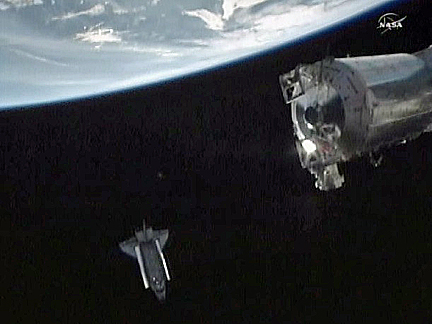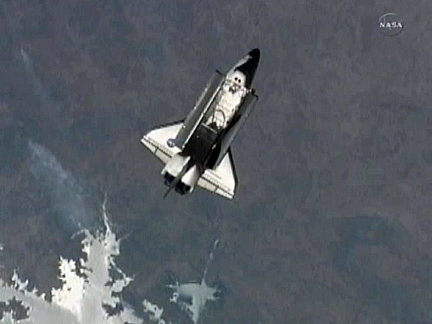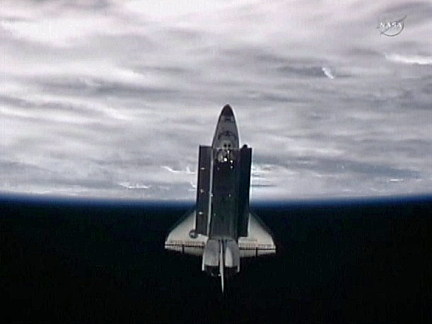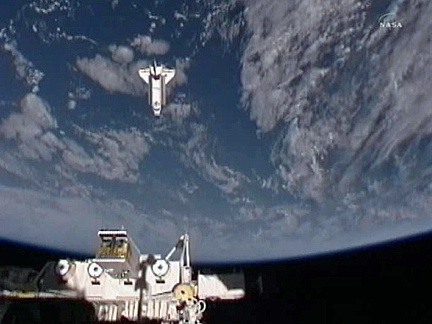Shuttle Endeavour undocks from International Space Station (UPDATED)
Editor's note...
CBS News
KENNEDY SPACE CENTER, FL--The shuttle Endeavour undocked from the International Space Station for the 12th and final time late Sunday, backing away for a fly-around photo survey before moving back to within 1,000 feet or so to test navigation sensors and software intended for use in NASA's next generation manned spacecraft.
Sailing 220 miles above Bolivia, the shuttle's docking system disengaged its counterpart on the space station's forward port at 11:55 p.m. EDT (GMT-4) and the orbiter pulled away directly in front of the lab complex.
"Houston and station, we have physical separation," an astronaut radioed as the two spacecraft separated.
A few moments later, space station flight engineer Ronald Garan rang the ship's bell in the forward Harmony module and, following naval tradition, announced "Endeavour, departing. Fair winds and following seas, guys."
"Thanks, Ron. We appreciate all the help," shuttle commander Mark Kelly replied.
"It was a pleasure serving with you boys," Garan said.
Following standard practice, pilot Gregory Johnson was at the controls for undocking, guiding the shuttle to a point about 400 feet directly in front of the outpost before kicking off a slow 360-degree photo-survey fly around, looping up above, behind, below and back out in front of the laboratory at a distance of about 600 feet. A small rocket firing then put Endeavour on a trajectory carrying it back above and behind the station.
Kelly took over at that point to carry out a partial re-rendezvous to test navigation sensors and software developed for NASA's next-generation spacecraft, the Multi-Purpose Crew Vehicle.
"It's the first time we'll be doing a re-rendezvous with space station, and it's a different kind of rendezvous," Kelly said in a pre-launch NASA interview. "The plan is after we undock, we'll go out to about 400 feet, we'll do a fly-around like we normally do, and then when we come up back in front of the space station again, we're then going to do this series of burns where we're going to fall behind.
"Then we're going to come back in doing a profile that's actually quite similar to what Apollo used for a rendezvous. Instead of coming up on the R-bar, which is right underneath the space station, or the V-bar, which is the direction it's going, we're going to come up on a 45-degree angle from behind. The sensor (is a) more advanced laser system, cameras, that can give some very accurate range and range-rate data. ... So we're going to test that as we come up to the space station."
Originally designed for the Bush administration's Constellation moon program, the four-seat MPCV capsule, known as Orion, is being developed by NASA for future flights to a variety of deep space targets, including the moon, near-Earth asteroids and, eventually, Mars.
Known by an acronym that's a stretch by even NASA standards -- the Sensor Test for Orion Relative Navigation Risk Mitigation -- the STORRM sensor package is mounted in the shuttle's cargo bay. It includes a high-definition camera and a laser that will flash on and off 30 times a second to "illuminate" targets mounted on the space station.
By analyzing reflected laser light, STORRM software can compute the distance between the two spacecraft and their relative velocity.
The STORRM equipment was operated by astronaut Andrew Feustel during Endeavour's approach to the station May 18 and engineers said it worked well. Since then, the recorder used to store data from the high definition docking camera failed and the system did not boot up for the post-undocking rendezvous test.
Even so, Heather Hinkel, the STORRM principal investigator, said the laser system worked as expected during the re-rendezvous Monday.
"We were able to get (laser) data throughout the entire undock, re-rendzvous and final separation trajectory," she said. "The software performed flawlessly. We had no anomalies."
Including data collected during docking, the STORRM system collected nearly 600 gigabytes of data that will be analyzed in the coming weeks to assess the system's performance.
Shuttle Flight Director Gary Horlacher said Endeavour flew a near-perfect trajectory for the test, dropping back about 29,000 feet before beginning its re-approach to the station.
"We did the fly-around, got our standard photos of the entire outside of the space station," he said. "Once the fly-around was complete, the crew started the STORRM trajectory. All those burns went perfectly, the trajectory was right on the money and everything just went really, really well."
Coming back toward the space station, "we targeted 1,000 feet below and 300 feet behind," Horlacher said. "We got to about 950 feet from the space station and the trajectory stalled out, the crew did not have to do any braking pulses whatsoever and we just fell away. So again, the trajectory was right on the money."
Horlacher said before launch that STORRM represented "an outstanding way to take advantage of the spaceflight capabilities we have today with the shuttle and the space station to demonstrate new technologies that will be used for future spacecraft."
"This capability is being designed for Orion, but is absolutely applicable for any spacecraft doing dockings, in lunar orbit, in Mars orbit, anywhere," he said. "To me, it's a very significant progression of advancing technologies for future applications."
A final separation burn was carried out at 4:38 a.m. and Endeavour departed the area.
"Over the past year and a half, it's been a pleasure to work with the software and hardware developers for STORRM," Feustel radioed. "Everybody did a great job getting the components ready for flight and we look forward to continued development of this hardware and software and hope that it contributes to the development of future vehicles."
"Drew we appreciate your words," astronaut Megan McArthur replied from mission control. "We've got a room full of happy people down here. Thanks very much."
With the STORRM test complete, Kelly, Gregory, Feustel and their crewmates -- Michael Fincke, Gregory Chamitoff and European Space Agency astronaut Roberto Vittori -- planned to call it a day and go to bed at 10:56 a.m. They will test the shuttle's re-entry systems overnight Monday and to pack up early Tuesday. If all goes well, Kelly will guide Endeavour to a landing back at the Kennedy Space Center around 2:35 a.m. Wednesday.
A few miles away, engineers will be wrapping up rollout of the shuttle Atlantis to pad 39A for work to ready the ship for launch July 8 on NASA's 135th and final shuttle mission. Rollout is scheduled to begin at 8 p.m. Tuesday, a few hours before Endeavour's re-entry begins.
Here is an updated timeline of the crew's planned activities for flight days 14 and 15 (in EDT and mission elapsed time; includes revision L of the NASA television schedule; best viewed with fixed-width font):
- Posted 08:34 PM EDT, 05/29/11: Endeavour astronauts prep for undocking
- Updated at 12:15 AM EDT, 05/30/11: Shuttle Endeavour undocks from space station
- Updated at 01:00 AM EDT, 05/30/11: Adding photos
- Updated at 05:30 AM EDT, 05/30/11: STORRM test complete
- Updated at 07:30 AM EDT, 05/30/11: Mission status briefing
CBS News
KENNEDY SPACE CENTER, FL--The shuttle Endeavour undocked from the International Space Station for the 12th and final time late Sunday, backing away for a fly-around photo survey before moving back to within 1,000 feet or so to test navigation sensors and software intended for use in NASA's next generation manned spacecraft.
 |
| The space shuttle Endeavour recedes from the International Space Station in this view from a camera mounted on the lab complex. (Credit NASA TV) |
 |
| Endeavour, directly below the space station, passes high above Australia. (Credit: NASA TV) |
 |
| Another view of Endeavour below the space station. (Credit: NASA TV) |
 |
| Endeavour passes off the southern coast of Australia. (Credit: NASA TV) |
"It was a pleasure serving with you boys," Garan said.
Following standard practice, pilot Gregory Johnson was at the controls for undocking, guiding the shuttle to a point about 400 feet directly in front of the outpost before kicking off a slow 360-degree photo-survey fly around, looping up above, behind, below and back out in front of the laboratory at a distance of about 600 feet. A small rocket firing then put Endeavour on a trajectory carrying it back above and behind the station.
Kelly took over at that point to carry out a partial re-rendezvous to test navigation sensors and software developed for NASA's next-generation spacecraft, the Multi-Purpose Crew Vehicle.
"It's the first time we'll be doing a re-rendezvous with space station, and it's a different kind of rendezvous," Kelly said in a pre-launch NASA interview. "The plan is after we undock, we'll go out to about 400 feet, we'll do a fly-around like we normally do, and then when we come up back in front of the space station again, we're then going to do this series of burns where we're going to fall behind.
"Then we're going to come back in doing a profile that's actually quite similar to what Apollo used for a rendezvous. Instead of coming up on the R-bar, which is right underneath the space station, or the V-bar, which is the direction it's going, we're going to come up on a 45-degree angle from behind. The sensor (is a) more advanced laser system, cameras, that can give some very accurate range and range-rate data. ... So we're going to test that as we come up to the space station."
Originally designed for the Bush administration's Constellation moon program, the four-seat MPCV capsule, known as Orion, is being developed by NASA for future flights to a variety of deep space targets, including the moon, near-Earth asteroids and, eventually, Mars.
Known by an acronym that's a stretch by even NASA standards -- the Sensor Test for Orion Relative Navigation Risk Mitigation -- the STORRM sensor package is mounted in the shuttle's cargo bay. It includes a high-definition camera and a laser that will flash on and off 30 times a second to "illuminate" targets mounted on the space station.
By analyzing reflected laser light, STORRM software can compute the distance between the two spacecraft and their relative velocity.
The STORRM equipment was operated by astronaut Andrew Feustel during Endeavour's approach to the station May 18 and engineers said it worked well. Since then, the recorder used to store data from the high definition docking camera failed and the system did not boot up for the post-undocking rendezvous test.
Even so, Heather Hinkel, the STORRM principal investigator, said the laser system worked as expected during the re-rendezvous Monday.
"We were able to get (laser) data throughout the entire undock, re-rendzvous and final separation trajectory," she said. "The software performed flawlessly. We had no anomalies."
Including data collected during docking, the STORRM system collected nearly 600 gigabytes of data that will be analyzed in the coming weeks to assess the system's performance.
Shuttle Flight Director Gary Horlacher said Endeavour flew a near-perfect trajectory for the test, dropping back about 29,000 feet before beginning its re-approach to the station.
"We did the fly-around, got our standard photos of the entire outside of the space station," he said. "Once the fly-around was complete, the crew started the STORRM trajectory. All those burns went perfectly, the trajectory was right on the money and everything just went really, really well."
Coming back toward the space station, "we targeted 1,000 feet below and 300 feet behind," Horlacher said. "We got to about 950 feet from the space station and the trajectory stalled out, the crew did not have to do any braking pulses whatsoever and we just fell away. So again, the trajectory was right on the money."
 |
| Endeavour crosses the coast of Libya at a distance of nearly 20,000 feet from the International Space Station at the end of the STORRM test. (Credit NASA TV) |
"This capability is being designed for Orion, but is absolutely applicable for any spacecraft doing dockings, in lunar orbit, in Mars orbit, anywhere," he said. "To me, it's a very significant progression of advancing technologies for future applications."
A final separation burn was carried out at 4:38 a.m. and Endeavour departed the area.
"Over the past year and a half, it's been a pleasure to work with the software and hardware developers for STORRM," Feustel radioed. "Everybody did a great job getting the components ready for flight and we look forward to continued development of this hardware and software and hope that it contributes to the development of future vehicles."
"Drew we appreciate your words," astronaut Megan McArthur replied from mission control. "We've got a room full of happy people down here. Thanks very much."
With the STORRM test complete, Kelly, Gregory, Feustel and their crewmates -- Michael Fincke, Gregory Chamitoff and European Space Agency astronaut Roberto Vittori -- planned to call it a day and go to bed at 10:56 a.m. They will test the shuttle's re-entry systems overnight Monday and to pack up early Tuesday. If all goes well, Kelly will guide Endeavour to a landing back at the Kennedy Space Center around 2:35 a.m. Wednesday.
A few miles away, engineers will be wrapping up rollout of the shuttle Atlantis to pad 39A for work to ready the ship for launch July 8 on NASA's 135th and final shuttle mission. Rollout is scheduled to begin at 8 p.m. Tuesday, a few hours before Endeavour's re-entry begins.
Here is an updated timeline of the crew's planned activities for flight days 14 and 15 (in EDT and mission elapsed time; includes revision L of the NASA television schedule; best viewed with fixed-width font):
DATE/EDT...DD...HH...MM...SS...EVENT
05/29
11:55 PM...13...14...59...00...UNDOCKING
11:56 PM...13...15...00...40...ISS holds attitude
05/30
12:00 AM...13...15...04...00...50 ft: reselect -X jets
12:02 AM...13...15...06...00...75 ft: low-z jets
12:13 AM...13...15...17...09...Sunrise
12:22 AM...13...15...26...00...Start flyaround at 400 ft
12:31 AM...13...15...35...30...Range = 600 feet
12:33 AM...13...15...37...00...ISS maneuvers to TEA attitude
12:33 AM...13...15...37...30...Shuttle directly above ISS
12:40 AM...13...15...44...48...Noon
12:45 AM...13...15...49...00...Shuttle directly behind ISS
12:56 AM...13...16...00...30...Shuttle directly below ISS
01:08 AM...13...16...12...00...Shuttle directly in front of ISS
01:08 AM...13...16...12...00...Separation burn No. 1
01:08 AM...13...16...12...26...Sunset
01:16 AM...13...16...20...00...STORRM* timeline begins
01:36 AM...13...16...40...00...Separation burn No. 2
01:44 AM...13...16...48...43...Sunrise
02:12 AM...13...17...16...17...Noon
02:24 AM...13...17...28...30...Range greater than 19,000 feet
02:36 AM...13...17...40...39...NH2 STORRM rocket firing
02:39 AM...13...17...43...51...Sunset
02:50 AM...13...17...54...40...Iss maneuvers to DTO attitude
02:58 AM...13...18...02...40...MC5 STORRM rocket firing
03:15 AM...13...18...19...58...Sunrise
03:23 AM...13...18...27...40...NSR STORRM rocket firing
03:28 AM...13...18...32...40...Range less than 20,000 feet (closest approach)
03:37 AM...13...18...41...40...MC6 STORRM rocket firing
03:57 AM...13...19...01...40...TPI STORRM rocket firing
04:11 AM...13...19...15...14...Sunset
04:38 AM...13...19...42...40...Separation burn No. 3
04:47 AM...13...19...51...20...Sunrise
04:56 AM...13...20...00...00...Crew meals begin
05:05 AM...13...20...09...40...Range greater than 20,000 feet
05:56 AM...13...21...00...00...EVA unpack and stow
06:30 AM...13...21...34...00...Mission status briefing on NASA TV
07:16 AM...13...22...20...00...Maui DTO
07:26 AM...13...22...30...00...Post EVA entry preps
07:56 AM...13...23...00...00...Undocking video playback
08:01 AM...13...23...05...00...Group B computer powerdown
08:11 AM...13...23...15...00...ISS daily planning conference
10:56 AM...14...02...00...00...STS crew sleep begins
01:00 PM...14...04...04...00...Mission Management Team briefing on NASA TV
06:56 PM...14...10...00...00...STS crew wakeup
09:06 PM...14...12...10...00...CBS News/network crew interviews
10:01 PM...14...13...05...00...Flight control system checkout
11:11 PM...14...14...15...00...Reaction control system hotfire
* Sensor Test for Orion Relative Navigation Risk Mitigation